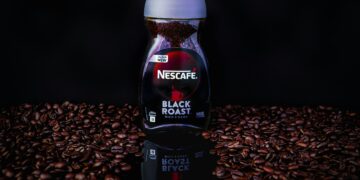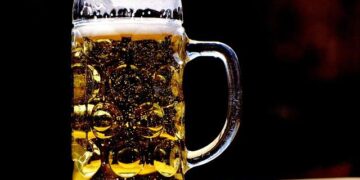Table of Contents
My name is Alex, and for the better part of a decade, I’ve been on a quest for the perfect cup of coffee.
This journey has taken me from a simple drip machine to the meticulous rituals of pour-over, but for years, my true obsession was the velvety, cascading nitro cold brew from my local specialty coffee shop.
It was my morning kickstart, my afternoon treat, and my single biggest discretionary expense.
At nearly $7 a cup, my habit was becoming unsustainable.
The logical next step, I thought, was to bring the operation in-house.
How hard could it be?
My first attempt at scaling up was a disaster.
Armed with a five-pound bag of beautiful, medium-roast Ethiopian beans and a food-safe bucket, I followed the standard advice I’d found online.
I tried a 1:5 coffee-to-water ratio, then a 1:8, then a 1:10.
I brewed for 12 hours, then 18, then a full 24.
I steeped in the fridge and at room temperature.
Each time, after the messy, laborious process of filtering gallons of liquid through a flimsy nut milk bag, the result was the same: an undrinkable brew that was simultaneously sour, bitter, and muddy.
It was, in a word, awful.1
I had wasted time, effort, and a small fortune in premium coffee beans only to produce something I wouldn’t even serve to my worst enemy.
That frustrating failure was my turning point.
I realized I was asking the wrong questions.
I was tweaking recipes when I should have been examining the entire system.
My problem wasn’t just about ratios and steep times; it was about extraction, filtration, and preservation at a scale that my kitchen tools couldn’t handle.
This realization sent me down a new rabbit hole, one that led me away from the coffee world and into the realm of homebrewing beer.
It was there, among the gleaming stainless steel kegs and complex gas lines, that I found the solution.
I learned that to get perfect cold brew on tap, I had to stop thinking like a barista making a single cup and start thinking like an engineer managing a delicate, closed-loop ecosystem.
This is the story of that journey—of the failures, the epiphany, and the step-by-step process that finally brought cafe-quality nitro cold brew into my home.
Part I: The Home-Brew Gauntlet: Why Standard Advice for Cold Brew Fails at Scale
The appeal of making cold brew at home is its supposed simplicity.
The internet is filled with guides that make it seem as easy as mixing coffee and water in a jar and waiting.
While this works for a single serving, the logic completely breaks down when you try to scale up.
The process isn’t linear; simply multiplying the ingredients in a bigger container introduces a host of new problems that degrade the quality of the final product.
I learned the hard way that there are three major hurdles—three horsemen of bad bulk brew—that standard advice fails to address.
The Three Horsemen of Bad Bulk Brew
1. Inconsistent Extraction
When you dump several pounds of coffee grounds into a large bucket, you create a deep, dense bed of coffee.
Water doesn’t saturate this mass evenly.
Pockets of dry grounds remain, while other areas become over-saturated.
This leads to a catastrophic failure in extraction.
Some of the coffee is under-extracted, lending a weak, sour taste.
Other parts are over-extracted, contributing harsh, bitter flavors.2 The principles are identical to those in other brewing methods; when scaling up a pour-over, for instance, a deeper coffee bed increases the water’s contact time, which can easily lead to bitterness and over-extraction if the grind size and technique aren’t adjusted accordingly.4 In a large immersion brew, a fine grind can even cause the grounds to clump together, preventing proper water flow entirely and guaranteeing a muddled, inconsistent final product.5
2. The Filtration Nightmare
Filtering a quart of cold brew through a cheesecloth is one thing; filtering five gallons is another.
It’s a messy, time-consuming ordeal that is shockingly ineffective.
No matter how careful you are, fine coffee particles and silt inevitably slip through.
This isn’t just a cosmetic issue; it has a profound impact on flavor.
One home brewer who successfully scaled his operation from his kitchen to a commercial brand noted that as he made bigger batches, he faced a new challenge: “grind leakage.” He found that the extra silt had a “noticeable effect on flavor, not in a good way”.6 This was a critical lesson for me.
The goal of filtration isn’t just to get clear coffee; it’s to remove the particles that contribute to a muddy, gritty mouthfeel and off-flavors.
Standard home methods are simply not up to the task at this scale.
3. The Oxygen Clock
Let’s say you manage to overcome the extraction and filtration hurdles and produce a decent-tasting batch of cold brew.
You store it in a large pitcher or dispenser in your fridge.
The moment you pour that first cup, a countdown begins.
With every pour, you introduce fresh oxygen into the container.
Oxygen is the enemy of fresh coffee.
It immediately begins to degrade the delicate aromatic oils you worked so hard to extract.
Experts warn that this process “promotes rapid and prolonged oxidation over time, doing irreparable harm to coffee’s essential, aroma-harboring oils, accompanied by fast-escalating acidity”.7 The result is that your cold brew tastes great on day one, a little stale on day two, and noticeably acidic and off by day three.
It became clear that the conventional wisdom was failing me.
My frustration wasn’t due to a bad recipe or poor-quality beans.
The problem was the system itself.
I was trying to operate in an open, uncontrolled environment that was inherently hostile to producing and preserving high-quality coffee at scale.
To succeed, I needed to change the environment entirely.
Part II: The Aquarium Epiphany: How I Learned to Stop Brewing Coffee and Start Managing an Ecosystem
My breakthrough came from an unexpected place: the world of homebrewing beer.
As I researched how brewers store and serve large quantities of beer while maintaining its quality, I discovered the kegerator.
At first, I saw it as just a fancy beer fridge.
But the more I learned, the more I realized it was the solution to every single problem I had faced.
A kegerator isn’t just a dispenser; it’s a closed, pressurized, and temperature-controlled environment.
It was the key to creating a stable ecosystem for my coffee.
This led to my “Aha!” moment, which I call the Aquarium Epiphany.
I realized that a home draft system is a delicate, closed-loop ecosystem, much like a high-tech home aquarium.
If you want your fish to thrive, you can’t just dump them in a bowl of tap water.
You have to meticulously manage their entire environment.
The same is true for cold brew on tap.
I began to see the entire setup through this new lens:
- The Inhabitants: The cold brew concentrate itself. This is the precious life you are trying to sustain. Its health, flavor, and longevity are entirely dependent on the quality of its environment.
- The Water Temperature: The kegerator’s refrigeration unit. Just like a tropical aquarium, the temperature must be precise and, most importantly, stable. Fluctuations can ruin the final product.8
- The Water Chemistry: The dispensing gas. This is the most critical and widely misunderstood element. The choice of gas—specifically, nitrogen versus carbon dioxide—is like setting the pH level of the water. The wrong choice will poison the entire tank and destroy the flavor of the coffee.10
- The Filtration & Purity: The cleanliness of the entire system, from the keg and lines to the faucets. Just as bacteria or contamination can wipe out an aquarium, a dirty draft system will introduce off-flavors and ruin your coffee.8
The fundamental power of this system is that it creates a closed loop.
By transferring the cold brew into a keg and pressurizing it with an inert gas, you create a stable, oxygen-free preservation chamber.
This single move solves the “Oxygen Clock” problem permanently.
The coffee is completely protected from oxidation, allowing it to maintain its fresh, nuanced flavor profile not for days, but for weeks or even up to a month.10
This was the paradigm shift I needed.
I wasn’t just buying a new appliance; I was building a life-support system for my coffee.
Part III: Assembling Your Coffee Ecosystem: A Component-by-Component Guide
Building your home draft system can feel intimidating, but when you approach it as assembling an ecosystem, each component’s role becomes clear.
This section will walk you through selecting the right parts and putting them together, using our aquarium analogy as a guide.
1. The Habitat: Choosing Your Kegerator
The kegerator is the foundation of your ecosystem.
It’s the temperature-controlled habitat where your coffee will live.
Maintaining a stable temperature between 36°F and 38°F is absolutely critical.
Warmer temperatures can cause the gas to come out of solution, resulting in excessively foamy pours, while colder temperatures can mute flavors.8
When selecting a kegerator, consider these key factors:
- Size and Capacity: Kegerators come in various sizes, from compact single-keg units to larger models that can hold multiple kegs. Think about how much coffee you consume and if you want to have different beverages on tap simultaneously.17
- Freestanding vs. Built-In: If you plan to install the kegerator under a counter in your kitchen or bar, you must choose a “built-in” model. These units are designed with front-facing ventilation to exhaust warm air. A standard freestanding model requires several inches of clearance on all sides and will overheat if enclosed in cabinetry.17
- Cost: Be prepared for an investment. Basic home models can start around $800, while larger, commercial-grade, or built-in units can easily exceed $2,000. This is a significant upfront cost, but one that pays for itself over time compared to a daily cafe habit.17
- Pro-Tip: Insist on Stainless Steel: When possible, choose a system where all components that touch the coffee—the faucet, the shank inside the tower, and the keg coupler—are made from 304-grade stainless steel. Cheaper chrome-plated brass components can corrode over time and impart metallic off-flavors into your coffee. Stainless steel is the brewer’s choice for a reason: it’s durable, hygienic, and flavor-neutral.9
2. The Inhabitants: Brewing a Perfect, Scalable Cold Brew Concentrate
Your system is only as good as the coffee you put in it.
The goal here is to create a clean, delicious, and consistent cold brew concentrate that will thrive in its new habitat.
Forget the bad habits from your bucket-brewing days; these are the golden rules for a scalable, keg-ready concentrate.
- Grind: Use a coarse grind, similar in consistency to coarse sea salt. A grind that is too fine will over-extract, leading to a bitter final product, and can create a sludgy mess that is difficult to filter.2
- Ratio: You are making a concentrate, which will be diluted later (either with water or when served over ice). A good starting point is a ratio between 1:4 and 1:8 (coffee to water by weight). A simple and effective recipe for a 5-gallon batch is to use approximately 3.5 to 4 pounds of coffee for 4 to 4.5 gallons of water.5
- Water and Temperature: Always use filtered water. The impurities and chlorine in tap water can introduce unwanted flavors.3 And despite the name “cold brew,” you should brew with room-temperature water (around 68°F). Water that is too cold will not extract the flavors effectively, resulting in a weak brew.2
- Steep Time: Let the coffee steep for 12 to 24 hours at room temperature. Less than 12 hours may be too weak, while steeping for more than 24 hours can start to extract undesirable woody and earthy flavors.2
- Filtration at Scale: To avoid the “Filtration Nightmare,” a two-stage process is essential for large batches. First, strain the brew through a coarse filter (like a large nut milk bag or a fine-mesh strainer) to remove the bulk of the grounds. Then, for a truly clean product, perform a second, finer filtration step. You can do this by slowly pouring the coffee through a large paper filter or, for even better results, using a dedicated 5-micron filter bag before transferring it into the keg. This second step is crucial for removing the fine silt that muddies the flavor and mouthfeel.5
3. The Atmosphere (The Most Critical Decision): Nitrogen vs. CO2
This is the most important decision you will make for your system, and it’s where most beginners go wrong.
The choice of gas is not about the bubbles; it’s about chemistry.
It dictates the long-term flavor and stability of your coffee.
- Why CO2 is the Enemy of Coffee: Many people with beer kegerators think they can simply hook up their existing CO2 tank to a keg of coffee. This is a catastrophic mistake. When carbon dioxide (CO2) dissolves in water (i.e., your coffee), it undergoes a chemical reaction to form carbonic acid (H2CO3).10 This acid gives carbonated beverages their characteristic sharp, tangy bite. In soda or beer, this is desirable. In coffee, it is disastrous. Carbonic acid introduces a distinct sour, metallic, and bitter taste that completely overpowers the delicate, nuanced flavors of the coffee.10 Using CO2 on your coffee is the equivalent of intentionally dumping acid into your pristine aquarium. It will ruin it.
- Why Pure Nitrogen is the Savior: Pure nitrogen (N2) is the undisputed king for dispensing coffee. The reason is simple: it is an inert gas. This means it does not react chemically with the coffee. It will not form acid, and it will not alter the flavor.11 Its only job is to provide pressure to push the coffee out of the keg and, in the case of nitro, to create texture.
- For “Still” Cold Brew: If you just want regular iced coffee on tap, you use pure nitrogen at a very low pressure, typically between 4 and 10 PSI. The nitrogen acts as a perfect piston and preservative, pushing the coffee out of the line while protecting it from oxygen.27
- For “Nitro” Cold Brew: To get that beautiful cascade and creamy head, you use pure nitrogen at a much higher pressure, between 30 and 45 PSI. This high pressure forces the nitrogen gas to dissolve into the coffee liquid. When the pressure is released at the tap, the gas comes out of solution, creating the magic.10
4. The Circulatory System: Lines, Couplers, and the All-Important Faucet
These are the components that move the coffee from the keg to your glass.
- Kegs: The standard for home dispensing is the Cornelius keg, often called a “Corny” keg. These are typically 5-gallon stainless steel tanks with a large, removable lid that makes them incredibly easy to fill, empty, and clean. They are the perfect vessel for your cold brew concentrate.28
- Lines and Disconnects: You will have two lines running to your keg. The “gas in” line connects from your nitrogen regulator to one post on the keg. The “liquid out” line runs from the other post up to the faucet. These lines attach via “disconnects” (either ball-lock or pin-lock style, which must match your keg type) that snap securely onto the keg posts.28
- The Faucet Divide: Standard vs. Stout: This is a crucial distinction that determines whether you serve still or nitro coffee.
- Standard Faucet: This is a simple on/off tap used for serving still cold brew. It allows the coffee to flow out unrestricted.31
- Stout (Nitro) Faucet: This faucet is absolutely required to create true nitro coffee. On the outside, it may look similar to a standard faucet, but inside it contains a critical component: a restrictor plate. This is a small metal disc with tiny holes. When you pull the tap handle, the high-pressure, nitrogen-infused coffee is forced through this plate. The intense agitation strips the nitrogen gas out of the solution, creating millions of microscopic bubbles. This process is what generates the iconic, beautiful cascade and the thick, creamy head that defines nitro coffee.10 Without a stout faucet, you simply cannot make nitro coffee, no matter how high you set your nitrogen pressure.
5. Bringing It All to Life: A Step-by-Step Assembly Guide
With your components selected, it’s time to assemble your ecosystem.
Follow these steps methodically.
It’s recommended to do this before plugging in the kegerator.
- Install Casters and Railing: Tip the empty kegerator on its side and screw in the caster wheels. Set it upright and snap the guard rail into place on top.33
- Install the Draft Tower: Remove the plug from the top of the kegerator. Feed the beer line from the bottom of the tower through the hole. Align the tower with the screw holes on top of the unit and secure it with the provided screws.34
- Attach the Faucet: Using a spanner wrench, attach your chosen faucet (standard or stout) to the tower shank. Ensure a rubber washer is in place to create a tight seal.34 Screw the tap handle onto the faucet.
- Connect the Gas Line to the Regulator: Push the gas line tubing firmly onto the hose barb on your nitrogen regulator. Use a hose clamp to secure it tightly.34
- Connect the Regulator to the Nitrogen Tank: Ensure the valve on the nitrogen tank is closed. Screw the regulator’s inlet nut onto the nitrogen tank valve and tighten it firmly with a wrench. There must be a nylon washer inside the nut to prevent leaks.34
- Check for Leaks (Critical Step): With all connections tight, slowly open the main valve on the nitrogen tank. Set the regulator to about 20 PSI. Mix some dish soap and water in a spray bottle and spray every single connection point: where the regulator meets the tank, where the hose meets the regulator, where the hose meets the keg disconnect, and around the keg lid once it’s sealed. If you see bubbles forming anywhere, you have a gas leak that must be tightened before proceeding.36
- Keg the Coffee: After brewing and filtering your cold brew, carefully pour it into your clean and sanitized Corny keg. Seal the lid.
- Connect the Keg: Attach the gas-in disconnect to the corresponding post on the keg (usually marked “IN”). Attach the liquid-out disconnect to the “OUT” post. Place the keg inside the kegerator.37
- Pressurize the System: Set your regulator to the desired pressure (4-10 PSI for still, 30-45 PSI for nitro). You will hear the gas flowing into the keg. Your ecosystem is now live.
Table 1: Home Draft System Component Checklist & Budget Guide
This table provides a clear, actionable shopping list and sets realistic budget expectations to help you plan your investment.
| Component | Purpose in the Ecosystem | Essential/Optional? | Typical Cost Range | Pro-Tip |
| Kegerator | The temperature-controlled habitat. | Essential | $600 – $2,500+ | Choose a front-venting model for built-in applications. Look for NSF-rated commercial models for durability.17 |
| Cornelius (Corny) Keg | The vessel that holds the inhabitants (coffee). | Essential | $75 – $150 | 5-gallon ball-lock kegs are the most common and easiest to find parts for.28 |
| Nitrogen (N2) Tank | Provides the inert atmosphere. | Essential | $80 – $200 | A 5 lb tank is good for home use, but a 10 or 20 lb tank requires less frequent refilling. Ensure it has a CGA 580 valve.40 |
| Dual Gauge Nitrogen Regulator | Controls the pressure of the atmosphere. | Essential | $60 – $120 | Must be a nitrogen-specific regulator (CGA 580 valve). A dual gauge shows both tank pressure and output pressure.10 |
| Stout (Nitro) Faucet | Creates the nitro cascade effect. | Essential for Nitro | $50 – $100 | Look for all stainless steel construction (e.g., Perlick or Intertap brands) to prevent off-flavors.10 |
| Standard Faucet | Dispenses still (non-nitro) coffee. | Essential for Still | $30 – $70 | Stainless steel is still highly recommended for longevity and flavor purity.9 |
| Gas & Liquid Lines/Disconnects | The circulatory system. | Essential | $20 – $40 (for a set) | Ensure your disconnects (ball-lock or pin-lock) match your keg type.28 |
| Line Cleaner & Sanitizer | The immune system; ensures purity. | Essential | $20 – $40 (per bottle) | Use a coffee-specific alkaline cleaner (for oils) and a no-rinse sanitizer (for microbes).13 |
| Quick Cascade Lid | Speeds up nitrogen infusion. | Optional | $50 – $80 | A great upgrade that infuses coffee in minutes instead of hours using a diffusion stone.10 |
Table 2: Still vs. Nitro Cold Brew: A Head-to-Head Comparison
This table provides a quick, scannable reference to eliminate confusion and clearly delineate the two paths you can take with your system.
| Feature | Still Cold Brew | Nitro Cold Brew |
| Primary Goal | Smooth, clean iced coffee on tap. | Creamy, velvety, cascading coffee with a thick foam head. |
| Gas Used | Pure Nitrogen (N2) | Pure Nitrogen (N2) |
| Pressure (PSI) | Low: 4 – 10 PSI | High: 30 – 45 PSI |
| Faucet Type | Standard Faucet | Stout (Nitro) Faucet with Restrictor Plate (Required) |
| Resulting Texture | Smooth, liquid, similar to standard iced coffee. | Velvety, creamy, rich, and thick, similar to a Guinness beer.43 |
| Resulting Taste | Clean, bright, showcases the coffee’s origin flavors. | Perceived as sweeter and less acidic due to the creamy texture, even with no sugar added.43 |
| Best For… | Purists who want the cleanest expression of the coffee, often served over ice. | Those seeking a rich, dairy-free, creamy experience. Best served without ice to preserve the texture.10 |
Part IV: Maintaining System Balance: Daily Operation and Long-Term Health
Your ecosystem is assembled, but the work isn’t over.
Like any delicate environment, it requires ongoing monitoring and maintenance to keep it healthy and thriving.
This means dialing in your system’s vitals, knowing how to diagnose problems, and adhering to a strict cleaning regimen.
1. Dialing in the Vitals: Pressure, Temperature, and Infusion
Getting the perfect pour every time requires a balance of three key variables.
- Pressure and Temperature: As established, your two most important settings are pressure and temperature. For still cold brew, keep the pressure low (4-10 PSI). For nitro, keep it high (30-45 PSI).27 For both, maintain a rock-solid temperature around 38°F. Temperature fluctuations are one of the primary causes of foamy, inconsistent pours in any draft system.8
- Nitrogen Infusion: For a spectacular nitro cascade, the nitrogen gas must be fully dissolved into the liquid coffee before it hits the faucet. There are a few ways to achieve this:
- The Shake Method: This is the fastest manual way. After pressurizing the keg to 30-45 PSI, disconnect the gas line, and shake the keg vigorously for 1-2 minutes. You will hear the gas being absorbed by the liquid. Reconnect and serve.28
- The Time Method: The simplest, no-effort method. Just let the pressurized keg sit undisturbed in the kegerator for 24-48 hours. The cold temperature and constant pressure will allow the nitrogen to dissolve naturally over time.10
- The Pro Upgrade (Quick Cascade Lid): For those who want instant gratification, a “Quick Cascade Lid” is a worthwhile investment. This special keg lid has a gas tube that runs to the bottom of the keg, ending in a 0.5-micron diffusion stone. It bubbles nitrogen up through the entire column of coffee, fully infusing the batch in a matter of minutes instead of hours or days.10
2. Troubleshooting Your Ecosystem: A Systematic Guide
Sooner or later, you’ll pull a pour that isn’t perfect.
When this happens, don’t panic or start randomly changing settings.
Most draft system problems, whether for beer or coffee, can be traced back to an imbalance in one of the three pillars of the ecosystem: Temperature, Pressure, or Cleanliness.
Instead of a frustrating guessing game, troubleshooting becomes a logical process of elimination.
If your coffee is “sick,” check the health of its environment.
This systematic approach transforms you from a confused user into a capable system manager.
The following troubleshooting matrix, adapted from professional draft beer guides, will help you diagnose and solve 99% of the issues you might encounter.8
Table 3: Draft System Troubleshooting Matrix
| Symptom (The “Sickness”) | Potential Cause (Ecosystem Imbalance) | Solution (How to Restore Balance) |
| Foamy / Wild Pour | Temperature Too High: Kegerator is above 40°F. | Check thermostat. Ensure proper air circulation around the unit. Let a newly installed keg chill for 24 hours.8 |
| Pressure Too High: Regulator is set above the recommended PSI. | For still coffee, lower PSI to 4-10. For nitro, ensure it’s in the 30-45 range but not excessively higher.8 | |
| Dirty Faucet/Lines: Buildup is causing agitation. | Perform a full line cleaning and faucet disassembly/cleaning.8 | |
| Flat / No Cascade (Nitro) | N2 Tank Empty: High-pressure gauge on regulator reads zero. | Replace or refill the nitrogen tank.47 |
| Pressure Too Low: Regulator is set below 30 PSI. | Increase pressure to the 30-45 PSI range.48 | |
| Not Fully Infused: Nitrogen hasn’t dissolved into the coffee. | Shake the keg for 1-2 minutes or let it rest under pressure for another 24 hours.10 | |
| Gas Leak: A leak is preventing the system from holding pressure. | Perform a soapy water leak test on all connections and tighten as needed.36 | |
| Sour / Bitter / “Off” Taste | CO2 Contamination: You are using CO2 or a CO2/N2 blend instead of pure nitrogen. | Immediately disconnect the gas. Purge the keg, discard the ruined coffee, and switch to a pure nitrogen tank and regulator.10 |
| Dirty Lines: Rancid coffee oils or bacteria are contaminating the flavor. | This is the most likely cause. Perform a deep cleaning of the entire system immediately.47 | |
| Cloudy / Silty Pour | Poor Pre-Keg Filtration: Fine coffee particles were not removed before kegging. | Let the keg sit undisturbed for a day for silt to settle. The first few pours may be cloudy. Improve your filtration process on the next batch.6 |
| Bacterial/Yeast Growth: The lines are contaminated. | Perform a deep cleaning and sanitization of the entire system.8 |
3. System Hygiene: The Non-Negotiable Cleaning Routine
This is the most overlooked but arguably most important part of maintaining your ecosystem.
Coffee contains natural oils, and over time, these oils build up on the inside of your keg, lines, and faucet.
These oils will go rancid and impart foul, stale flavors onto every cup you pour.
Furthermore, the cold, low-acid environment of a draft system is a potential breeding ground for bacteria and mold.12
Regular, thorough cleaning is non-negotiable for both flavor and food safety.
It’s critical to understand the difference between cleaning and sanitizing:
- Cleaning: The process of removing physical soil and residue—in this case, coffee oils. For this, you need an alkaline cleaner specifically formulated to break down coffee oils. Products like Urnex Clearly Cold are designed for this purpose. Standard Beer Line Cleaner (BLC) may not be as effective on stubborn coffee residue.13
- Sanitizing: The process of killing invisible microorganisms like bacteria and yeast. This is done after cleaning a surface. Use a no-rinse, food-grade sanitizer like Star San or Urnex Complete Cafe. Remember the cardinal rule: “An unclean surface cannot be sanitized”.13
Follow this two-tiered cleaning schedule:
- Between Each Keg (Every 2-4 Weeks): Perform a full system flush. Disconnect the coffee keg. Fill a separate cleaning keg (or use a hand-pump cleaning kit) with the recommended dilution of your alkaline cleaner. Push the entire volume of cleaner through the lines and faucet. Flush the system thoroughly with clean water. Finally, push a solution of no-rinse sanitizer through the lines. You are now ready to tap your next keg of coffee.52
- Quarterly Deep Clean: Every three months, completely disassemble your system. Remove the faucets, couplers, and all disconnects. Soak them in a warm solution of your alkaline cleaner for at least 30 minutes to dissolve any hidden buildup. Use a faucet brush to scrub the interior of the faucets and shanks. Rinse, sanitize, and reassemble.36
Conclusion: The Perfect Pour, Every Morning
I’ll never forget the first time I pulled the handle on my fully assembled system.
I watched, mesmerized, as the dark liquid cascaded in the glass, settling into a perfect, creamy, Guinness-like head.
The taste was everything I had been chasing: smooth, rich, and complex, without a hint of the bitterness or acidity that had plagued my earlier attempts.
It was better than the coffee from the shop, and it was flowing from a tap in my own kitchen.
The journey had been a long one, filled with frustrating failures and expensive lessons, but that single, perfect pour made it all worthwhile.
The initial investment in a home draft system is not insignificant.
The equipment can be costly, and there is a learning curve.
But the payoff is immense.
You gain unparalleled quality control, the ultimate convenience of cafe-quality coffee on demand, and significant long-term financial savings.
A conservative estimate shows that a daily coffee drinker can save between $800 and $1,200 a year compared to buying from a cafe, allowing the system to pay for itself relatively quickly.56
More than the money, however, is the satisfaction.
By embracing the “ecosystem” mindset—by understanding that you are managing a delicate balance of temperature, chemistry, and purity—you move beyond simply following a recipe.
You become the master of your own perfect cup of coffee.
You gain the knowledge to do it right, to troubleshoot it when it’s wrong, and to enjoy the fruits of your labor with every single pull of the tap.
For any true coffee lover, that is a reward without a price.
Works cited
- Need help troubleshooting making my own coldbrew. : r/coldbrew, accessed August 1, 2025, https://www.reddit.com/r/coldbrew/comments/1kbs544/need_help_troubleshooting_making_my_own_coldbrew/
- 10 Mistakes Everyone Makes With Homemade Cold Brew, According To An Expert Barista, accessed August 1, 2025, https://www.foodie.com/1528341/mistakes-steeping-cold-brew-list/
- Six Common Mistakes When Making Cold Brew Coffee, accessed August 1, 2025, https://groundsandhoundscoffee.com/blogs/recent-posts/six-common-mistakes-when-making-cold-brew-coffee
- How do I maintain results when scaling up brew size? : r/pourover – Reddit, accessed August 1, 2025, https://www.reddit.com/r/pourover/comments/19cy2rp/how_do_i_maintain_results_when_scaling_up_brew/
- Cold Brewing (Home-Made) – Q&A – Barista Hustle Community Forum, accessed August 1, 2025, https://community.baristahustle.com/t/cold-brewing-home-made/1066
- From Kitchen to Kegs: How I Built a Cold Brew Coffee Brand from …, accessed August 1, 2025, https://medium.com/@justbustinarown/from-kitchen-to-kegs-how-i-built-a-cold-brew-coffee-brand-from-scratch-89de8b325ead
- 5 Iced Coffee Mistakes You’re Probably Making, According to a Master Barista – EatingWell, accessed August 1, 2025, https://www.eatingwell.com/article/7836007/iced-coffee-mistakes-youre-probably-making-according-to-a-master-barista/
- Troubleshooting Kegging Issues – Midwest Supplies, accessed August 1, 2025, https://www.midwestsupplies.com/blogs/bottled-knowledge/what-are-some-common-troubleshooting-issues-regarding-kegs-and-dispensing
- Draft Beer Systems Guide: Know the 10 Key Elements, accessed August 1, 2025, https://www.micromatic.com/en-us/learn/dispensing-knowledge/learning-center/10-key-elements-of-a-draft-beer-system
- How To Put Your Cold Brew Coffee On Draft – Kegerator.com, accessed August 1, 2025, https://learn.kegerator.com/how-to-put-your-cold-brew-coffee-on-draft/
- Why is coffee sometimes nitrated but never carbonated? – Coffee Stack Exchange, accessed August 1, 2025, https://coffee.stackexchange.com/questions/5435/why-is-coffee-sometimes-nitrated-but-never-carbonated
- cold brew & nitro, accessed August 1, 2025, https://urnex.com/media/wysiwyg/Urnex/Cold_Brew_and_Nitro_Equipment_Cleaning.pdf
- Cleaning and Sanitizing Cold Brew Coffee Equipment and Draft Systems – Drips & Draughts, accessed August 1, 2025, https://www.dripsanddraughts.com/058-cleaning-and-sanitizing-cold-brew-coffee-equipment-and-draft-systems/
- How to Cold Brew Coffee and Serve Iced Coffee on Tap – Keg Outlet, accessed August 1, 2025, https://www.kegoutlet.com/blog/how-to-cold-brew-coffee-and-serve-coffee-on-tap/
- Cold Brew & Nitro Coffee Dispenser Kegerators – Beverage Factory, accessed August 1, 2025, https://www.beveragefactory.com/coffee/iced-coffee-dispenser/index.html
- Is Nitro Cold Brew worth $6 to you? : r/Coffee – Reddit, accessed August 1, 2025, https://www.reddit.com/r/Coffee/comments/9b98mq/is_nitro_cold_brew_worth_6_to_you/
- Frequently Asked Questions: Kegerators | Summit® Appliance, accessed August 1, 2025, https://www.summitappliance.com/blog/kegerator-faq
- Kegerator – Wikipedia, accessed August 1, 2025, https://en.wikipedia.org/wiki/Kegerator
- Draft Beer 101: Guide to Building, Using & Maintaining Draft Beer Systems – Kegworks, accessed August 1, 2025, https://www.kegworks.com/blog/draft-beer-101
- Cold Brew Kegerators – Kegco.com, accessed August 1, 2025, https://kegco.com/collections/cold-brew-kegerators
- Cold Brew & Nitro Coffee Kegerators for Serving Draft Coffee – Keg Outlet, accessed August 1, 2025, https://www.kegoutlet.com/cold-brew-nitro-coffee-kegerators.html
- The Elements of a Commercial Draft Beer System – AHFP – A Head for Profits, accessed August 1, 2025, https://aheadforprofits.com/commercial-draft-beer-system-elements/
- I figured it out! (Cold Brew Guide) : r/Coffee – Reddit, accessed August 1, 2025, https://www.reddit.com/r/Coffee/comments/k4zhv6/i_figured_it_out_cold_brew_guide/
- How CO2 Affects the Taste and Fizz of Carbonated Beverages – Reliant BevCarb, accessed August 1, 2025, https://www.reliantbevcarb.com/post/how-co2-affects-the-taste-and-fizz-of-carbonated-beverages
- eastforged.com, accessed August 1, 2025, https://eastforged.com/blogs/spills/everything-you-need-to-know-about-nitrogenated-vs-carbonated-drinks#:~:text=As%20nitrogen%20is%20inert%20%2D%20unlike,Forged%20brews%20tastes%20like%20tea.
- What Is Nitro Brew? How It’s Made and Why It’s Different – CO2 Monitoring, LLC, accessed August 1, 2025, https://aerospheremonitoring.com/blogs/news/cold-brew-nitro-brew-post
- Setting Up Your Cold Brew & Nitro Coffee Kegerator – YouTube, accessed August 1, 2025, https://www.youtube.com/watch?v=cHTGO7ARAyk
- Put a batch of nitro cold brew on tap last weekend. Highly recommend. : r/coldbrew – Reddit, accessed August 1, 2025, https://www.reddit.com/r/coldbrew/comments/trwmtr/put_a_batch_of_nitro_cold_brew_on_tap_last/
- Bulk nitro cold brew at home? : r/coldbrew – Reddit, accessed August 1, 2025, https://www.reddit.com/r/coldbrew/comments/zilpc2/bulk_nitro_cold_brew_at_home/
- Cold Brew Coffee Kegerator – Single Tap for Iced Coffee, accessed August 1, 2025, https://www.coldbrewavenue.com/cold-brew-coffee-kegerator-single-tap-for-iced-coffee.html
- Cold Brew Taps vs Nitro Taps (Faucets for Coffee/Beer) – Keg Outlet, accessed August 1, 2025, https://www.kegoutlet.com/cold-brew-taps-vs-nitro-taps-faucets.html
- Nitro coffee vs. Cold brew coffee – What are the differences?, accessed August 1, 2025, https://bataviacoffee.com/learn-more/cold-brew-coffee/nitro-coffee-vs-cold-brew/?lang=en
- Step-by-Step: Kegerator Assembly & Installation Guide, accessed August 1, 2025, https://learn.kegerator.com/assembly-guide/
- How to Set Up a Kegerator: A Step-by-Step Assembly Guide, accessed August 1, 2025, https://www.kegworks.com/blog/how-to-set-up-a-kegerator-a-step-by-step-assembly-guide
- How to Set Up Your KC1000SS Kegerator, accessed August 1, 2025, https://learn.kegerator.com/kc1000ss-assembly/
- How to Keg Your Homebrew: Troubleshooting Tips – Serious Eats, accessed August 1, 2025, https://www.seriouseats.com/homebrewing-how-to-keg-your-beer-troubleshooting-tips
- installation instructions for cold brew coffee tap kits – Summit Appliance, accessed August 1, 2025, https://www.summitappliance.com/document/466
- Cold Brew Coffee Commercial Kegerator – Still (Stainless Steel), accessed August 1, 2025, https://www.kegoutlet.com/still-cold-brew-coffee-commercial-kegerator-stainless-steel.html
- Commercial Kegerator – UBC KegMaster 2 – Nitro Cold Brew Edition – 2-Tap Tower + Nitrogen Infuser Kit – Beverage Craft, accessed August 1, 2025, https://www.beveragecraft.com/commercial-kegerator-ubc-kegmaster-2-nitro-cold-brew-edition-2-tap-tower-nitrogen-infuser-kit/
- Basic Draft Beer Components – Micro Matic, accessed August 1, 2025, https://www.micromatic.com/en-us/learn/dispensing-knowledge/learning-resource-center/basic-draft-beer-components
- Parts of a Draft Beer System & How They Work [Diagram] – Kegworks, accessed August 1, 2025, https://www.kegworks.com/blog/parts-of-a-draft-system
- Cold Brew and Nitro Coffee Cleaner & Sanitizer – Keg Outlet, accessed August 1, 2025, https://www.kegoutlet.com/cold-brew-coffee-cleaner-sanitizer.html
- What’s The Difference Between Nitro Cold Brew And Cold Brew? | Front Range Fed, accessed August 1, 2025, https://www.frontrangefed.com/whats-the-difference-between-nitro-cold-brew-and-cold-brew/
- What’s Different About Nitro Cold Brew? – TMCRAFT, accessed August 1, 2025, https://tmcraftus.com/blogs/beer-keg/whats-different-about-nitro-cold-brew
- Your guide to Nitro Cold Brew Coffee, accessed August 1, 2025, https://melscoffeetravels.com/your-guide-to-nitro-cold-brew-coffee/
- How to Set Up Your Kegerator for Nitro Coffee – YouTube, accessed August 1, 2025, https://www.youtube.com/watch?v=fNMhMn_qZDo
- Draft Beer Troubleshooting – Eagle Distributing, accessed August 1, 2025, https://www.eagledistributing.com/retailer-tools/draft-beer-troubleshooting/
- Essential Draft Troubleshooting Tips for Beverage Professionals – SevenFifty Daily, accessed August 1, 2025, https://daily.sevenfifty.com/how-to-troubleshoot-common-draft-problems/
- Cleaning coffee oils from drip coffee pot reservoir – Reddit, accessed August 1, 2025, https://www.reddit.com/r/Coffee/comments/5hhqjb/cleaning_coffee_oils_from_drip_coffee_pot/
- Cold brew line cleaning chemical – Dispense Forum | Discuss Keg Beer, Kegerators, Wine On Tap, and more! – Micro Matic, accessed August 1, 2025, https://forum.micromatic.com/forum/us-en/forum/bar-pub-restaurant-dispensing-commercial/trouble-shooting-beer-quality/142916-cold-brew-line-cleaning-chemical
- Best way to remove coffee flavor from draft lines? : r/TheBrewery – Reddit, accessed August 1, 2025, https://www.reddit.com/r/TheBrewery/comments/b3ivcb/best_way_to_remove_coffee_flavor_from_draft_lines/
- How to clean cold brew system for Clean Play? : r/starbucks – Reddit, accessed August 1, 2025, https://www.reddit.com/r/starbucks/comments/xlhb0d/how_to_clean_cold_brew_system_for_clean_play/
- How to Clean Tap Lines on Brewsky Fridge – YouTube, accessed August 1, 2025, https://www.youtube.com/watch?v=r6q3QY5L5Yk
- How To Clean a Kegerator: The Basics of Beer Line Cleaning – Kegworks, accessed August 1, 2025, https://www.kegworks.com/blog/draft-beer-101-the-basics-of-beer-line-cleaning
- How To Clean Kegerator Lines – Kane’s Draft Service, accessed August 1, 2025, https://www.kdsbeergeek.com/how-to-clean-kegerator-lines/
- DIY Nitro Cold Brew: Make Café-Quality Coffee at Home for 70% Less, accessed August 1, 2025, https://www.coffeeoncue.com.au/blogs/how-to-make-coffee/diy-nitro-cold-brew-make-cafe-quality-coffee-at-home-for-less






